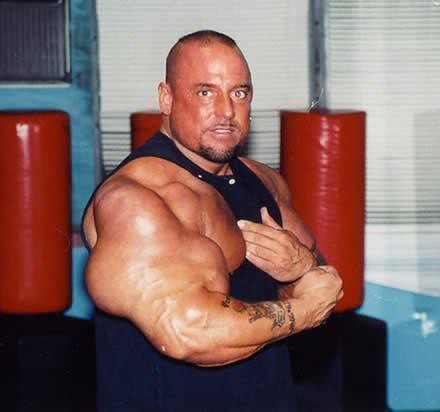Then you see people who look like this, who are so far outside the normal range that they can't possibly be achieving those results naturally.
I'm sure that some of them really are doing it through nothing but hard work and a good diet, but steroid abuse exists in a big way, particularly in professional bodybuilding.
It's important to note first of all that not all steroids have this effect, and not all steroids are illegal - the two main groups are corticosteroids and anabolic steroids. In this post, if I refer to steroids without a prefix, assume it's the latter - I might do another post on cortico's another time.
These are a group of drugs that work by mimicking natural hormones (testosterone and dihydrotestosterone), although they are synthetic. Their effect is to increase protein synthesis and also to make users more manly (i.e., enlarged vocal cords and testicles, hairier bodies, etc. etc.).
Because they are fat soluble, they are not hampered by cell membranes, which means they don't have to rely on manipulating the receptors on the outside of the cell; in fact, the androgen receptor that the hormone binds to is in the cytoplasm - compared to the quite small, organic structure of the steroid, the receptor is huge, so when the receptor passes through the membrane of the nucleus, the hormone stays bound to it and enters with it. From the nucleus, the receptor-hormone complex can send signals to the rest of the cell or alter how certain genes are expressed.
 |
| Spot the steroid abuser. |
To understand how they produce the massive increase in muscle, you have to understand how muscle is built in the first place. When exercised, muscles require energy. A lot of this energy can be released through the oxidation of glucose via aerobic respiration, but not all. Some energy comes from the synthesis of ATP through the oxidation of proteins, lipids or other cellular matter. Oxidising the protein in the muscle means that you lose muscle mass, a process called catabolism, which is started by a hormone called cortisol. The ATP is also used in anabolism - the opposite of catabolism - whereby amino acids are reformed into proteins. This way, the overall muscle mass increases.
Anabolic steroids block catabolic hormones from acting on muscle, so not as much muscle mass is lost in the catabolic stage of exercise. They can also make cells favour differentiating into muscle as opposed to fatty tissue. In addition to those two, they increase protein synthesis. The way they do this is by binding to specific sites on the DNA, which changes the rate of transcription of that particular bit of code. In doing this, they alter the number of certain proteins produced, be they messenger molecules or more muscle.
I'll do another post explaining about androgenic effects and why they can be dangerous (but also helpful); watch this space!

No comments:
Post a Comment